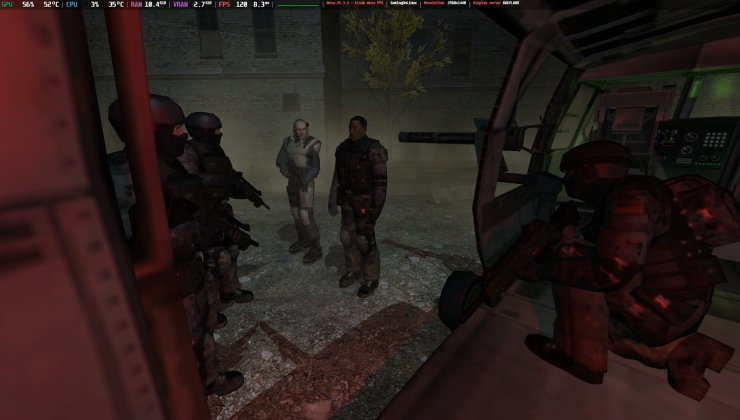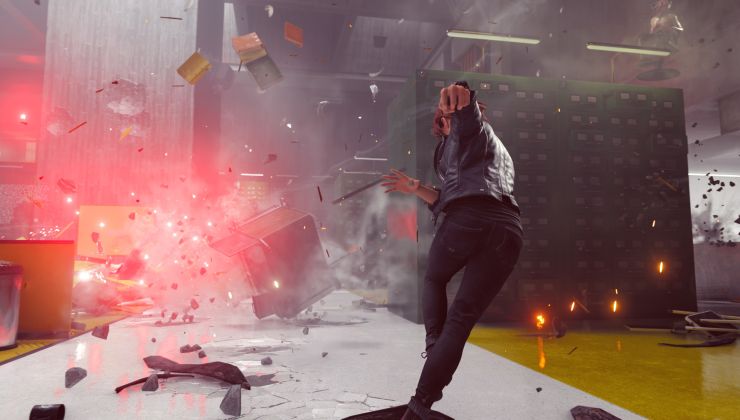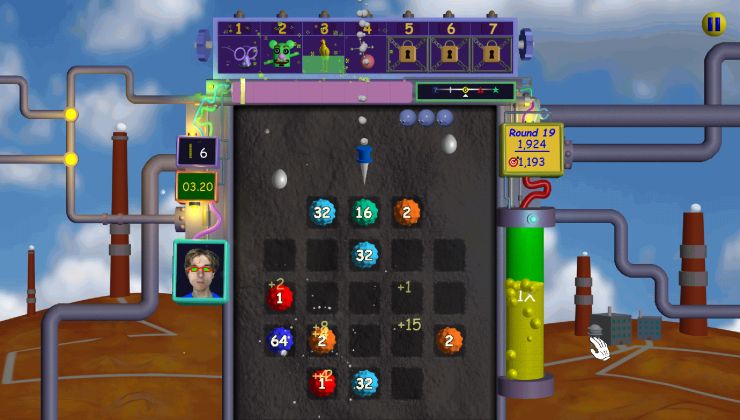I did it, I jumped ship from Ubuntu to Antergos and I honestly can’t see myself going back. Here’s some thoughts on that.
Why I switched
There’s many reasons for my switch, but the main one has been stability. Ubuntu has been getting more problem-filled with every new release for me so I had enough. Not only that, but due to it being dependent on GNOME packages, stuff was being stripped away too and it’s just a mess now. Some applications have normal title-bars, some have GNOME’s new styling with everything sodding hidden and it’s just all mashed together.
Audacity would constantly screw up and just skip over audio while trying to record or playback, or just flat out not work.
Multiple games wouldn’t give me audio until I killed PulseAudio and reloaded it or did other trickery. It was becoming a nuisance, especially when I want to livestream and “oh sorry guys, let me fix my audio, fuc…”.
It seems Ubuntu has a lot of problems with their setup of PulseAudio. I don’t know what they’re doing to it, but they’re murdering the poor thing.
Antergos, I choose you!
If Antergos is anything, it’s like walking in heavy rain without a coat and — suddenly the clouds part and the almighty sun is shining down on you to make everything better. Something like this essentially (thanks Samsai):

I’mdefinitely probably not overselling it — okay maybe a little.
I adore the Arch User Repository (AUR) and have found it so incredibly useful for multiple applications I use on a daily basis, especially when those same applications on Ubuntu could be out of date for weeks and months. The brand new Minecraft launcher was in it the day it was release by the official developers, the itch.io app is in it, everything I need is right there and tested by tons of people. It’s essentially a far better PPA-like system. It’s easier to understand too, thanks to a much clearer layout on the actual website.
Just don't outright trust everything on the AUR, make sure you read a few comments before installing a random package. I'm sure you're all smart enough to know to do that anyway.
Getting used to KDE after being on GNOME or GNOME-like desktops for many years has been a challenge by itself, but wow, it’s actually a lot nicer. Things aren’t hidden away where I don’t expect them to be, if I want something it’s usually right where I would expect it in a proper menu.
There was two “gotchas” I had to sort out. I couldn’t figure out why OBS Studio wouldn’t pick up any video, so eventually I tested gaming and games ran at 5 FPS. Turns out that installing the nvidia drivers didn’t come with the 32bit libs as a dependency. So, if you do decide to check out Antergos with Nvidia, make sure “lib32-nvidia-libgl” is installed too. This took me a good day to figure out too, as I didn’t think to test games until the next day and that made me realize it was a driver issue.
The second was that one day I booted up to a black screen with a cursor, as the system booted so fast that LightDM didn't load (Arch Wiki entry). I had to edit "/etc/lightdm/lightdm.conf" to include:
I also learnt about bash aliases thanks to being on Arch, so instead of running something I can never remember like “Yuarty -sYusudaadasdas” to update, I have it setup so I just run “upall” in terminal and it updates everything for me — glorious! It’s easy to do as well, simply edit:
Add at the bottom:
You can substitute “yaourt -Syua” for anything, like “apt-get update && apt-get upgrade” for Debian/Ubuntu and so on.
And then save it.
Lastly, enjoy a shot of my KDE Antergos dual-desktop:

Seriously, you should give Antergos a try. It’s Arch, but a more tame Arch since it has a live-media option and you can pick what desktop you want from the installer. This was a key selling point for me, and the installer was a breeze too.
Why I switched
There’s many reasons for my switch, but the main one has been stability. Ubuntu has been getting more problem-filled with every new release for me so I had enough. Not only that, but due to it being dependent on GNOME packages, stuff was being stripped away too and it’s just a mess now. Some applications have normal title-bars, some have GNOME’s new styling with everything sodding hidden and it’s just all mashed together.
Audacity would constantly screw up and just skip over audio while trying to record or playback, or just flat out not work.
Multiple games wouldn’t give me audio until I killed PulseAudio and reloaded it or did other trickery. It was becoming a nuisance, especially when I want to livestream and “oh sorry guys, let me fix my audio, fuc…”.
It seems Ubuntu has a lot of problems with their setup of PulseAudio. I don’t know what they’re doing to it, but they’re murdering the poor thing.
Antergos, I choose you!
If Antergos is anything, it’s like walking in heavy rain without a coat and — suddenly the clouds part and the almighty sun is shining down on you to make everything better. Something like this essentially (thanks Samsai):

I’m
I adore the Arch User Repository (AUR) and have found it so incredibly useful for multiple applications I use on a daily basis, especially when those same applications on Ubuntu could be out of date for weeks and months. The brand new Minecraft launcher was in it the day it was release by the official developers, the itch.io app is in it, everything I need is right there and tested by tons of people. It’s essentially a far better PPA-like system. It’s easier to understand too, thanks to a much clearer layout on the actual website.
Just don't outright trust everything on the AUR, make sure you read a few comments before installing a random package. I'm sure you're all smart enough to know to do that anyway.
Getting used to KDE after being on GNOME or GNOME-like desktops for many years has been a challenge by itself, but wow, it’s actually a lot nicer. Things aren’t hidden away where I don’t expect them to be, if I want something it’s usually right where I would expect it in a proper menu.
There was two “gotchas” I had to sort out. I couldn’t figure out why OBS Studio wouldn’t pick up any video, so eventually I tested gaming and games ran at 5 FPS. Turns out that installing the nvidia drivers didn’t come with the 32bit libs as a dependency. So, if you do decide to check out Antergos with Nvidia, make sure “lib32-nvidia-libgl” is installed too. This took me a good day to figure out too, as I didn’t think to test games until the next day and that made me realize it was a driver issue.
The second was that one day I booted up to a black screen with a cursor, as the system booted so fast that LightDM didn't load (Arch Wiki entry). I had to edit "/etc/lightdm/lightdm.conf" to include:
[LightDM]
logind-check-graphical=trueI also learnt about bash aliases thanks to being on Arch, so instead of running something I can never remember like “Yuarty -sYusudaadasdas” to update, I have it setup so I just run “upall” in terminal and it updates everything for me — glorious! It’s easy to do as well, simply edit:
~/.bashrcAdd at the bottom:
alias upall='yaourt -Syua'You can substitute “yaourt -Syua” for anything, like “apt-get update && apt-get upgrade” for Debian/Ubuntu and so on.
And then save it.
Lastly, enjoy a shot of my KDE Antergos dual-desktop:

Seriously, you should give Antergos a try. It’s Arch, but a more tame Arch since it has a live-media option and you can pick what desktop you want from the installer. This was a key selling point for me, and the installer was a breeze too.
Some you may have missed, popular articles from the last month:
All posts need to follow our rules. For users logged in: please hit the Report Flag icon on any post that breaks the rules or contains illegal / harmful content. Guest readers can email us for any issues.
You guys always make me feel so dumb.
I run Mint with Cinnamon and have not hit a single issue with anything. But I admittedly don't understand most of the words or acronyms in this entire comment section. Thankfully for me, the days of needing to be a computer genius to run Linux are over.
So yeah, consider me to be that guy sitting in the corner nodding politely and occasionally interjecting with improperly timed generic platitudes.
I run Mint with Cinnamon and have not hit a single issue with anything. But I admittedly don't understand most of the words or acronyms in this entire comment section. Thankfully for me, the days of needing to be a computer genius to run Linux are over.
So yeah, consider me to be that guy sitting in the corner nodding politely and occasionally interjecting with improperly timed generic platitudes.
9 Likes
You guys always make me feel so dumb.
I run Mint with Cinnamon and have not hit a single issue with anything. But I admittedly don't understand most of the words or acronyms in this entire comment section. Thankfully for me, the days of needing to be a computer genius to run Linux are over.
So yeah, consider me to be that guy sitting in the corner nodding politely and occasionally interjecting with improperly timed generic platitudes.
You sound just like I did not long ago. In my personal experience with Linux, mind you I am not a pro and have a lot to learn. Learning to install Arch the Arch way taught me a lot about Linux. The wiki and community are fantastic resources. I recommend giving it a try. You will quickly be talking like a pro. I have never tried Antergos but it looks great.
1 Likes
Man all this talk of switching to Arch, now I'm tempted to give it another shot :)
Last edited by chimpy on 19 Jan 2017 at 3:28 am UTC
Last edited by chimpy on 19 Jan 2017 at 3:28 am UTC
1 Likes
I haven't had the same issues you have with Ubuntu, but I'm running Ubuntu 16.10 with Cinnamon myself. I used to run Mint 17.3, but to support my new RX480 card I had to break from tradition a bit. I still use Mint 17.3 at work, with my laptop running Fedora right now so I can test Wayland+Gnome.
I should try KDE myself, last I tried it, it struggled with the AMDGPU-PRO drivers on Ubuntu 16.04 (as did Cinnamon.) Now that I'm on plain AMDGPU, it might work better.
I should try Arch at some point, but I'm pretty happy with my setup right now.
I should try KDE myself, last I tried it, it struggled with the AMDGPU-PRO drivers on Ubuntu 16.04 (as did Cinnamon.) Now that I'm on plain AMDGPU, it might work better.
I should try Arch at some point, but I'm pretty happy with my setup right now.
0 Likes
The AUR is like the killer "feature" the arch universe has.
For me, the wiki is Arch's killer feature, with the AUR a close second.
5 Likes
OpenSUSE, KDE,and YaST. I am set :)
1 Likes
Antergos is great, I installed Ubuntu then went right back. It's horrible that installing Nvidia is such a headache, I didn't even install and am not gaming.
0 Likes
Man all this talk of switching to Arch, now I'm tempted to give it another shot :)
if u just want test use distro dont pure arch,,, too many think to do before its ready to use
0 Likes
Man all this talk of switching to Arch, now I'm tempted to give it another shot :)Give a shot at Fedora, it's the future!
I tried a lot of distros for the past 10 years (from Debian to Arch), but at my surprise, I tried Fedora a year ago and I think it's one of the best so far.
2 Likes
@liamdawe : To be more precise, AUR is a port-like system - which means it's been designed after FreeBSD's ports system, or like Gentoo.
Fine to see that you went on and switched to another distribution, as it is one of the many advantages of the Linux world. I started using Linux with a good old SuSE back when was in high school, after this I installed Ubuntu on my first x86 laptop - before that I had an iBook running Mac OS 9. That HP laptop lasted 2 years and died, t'was the last time I'd buy HP, ever.
After this I got my hands on a Pentium IV that used to be my main workstation. By then I was using Debian but I wasn't satisfied with some of their policies, so I switched to Fedora. That was around Fedora 11. I stick with it for a year or so, but I wanted more. I tried to switch to Gentoo, but the end result was not very convincing... So I settled with pure Arch Linux, somewhere around 2010 or 2011, only to switch back to Fedora two years ago.
I've been using many desktop environments, including XFCE, KDE 3 and 4, E17, my own OpenBox configuration, and GNOME 2 and 3, which I now stick with.
I want to state that switching over like I did allowed me to see many great things and ideas from developers that are invested in what they do and do it in a creative fashion. That's something proprietary Operating Systems lack these days: passion and creativity.
Fine to see that you went on and switched to another distribution, as it is one of the many advantages of the Linux world. I started using Linux with a good old SuSE back when was in high school, after this I installed Ubuntu on my first x86 laptop - before that I had an iBook running Mac OS 9. That HP laptop lasted 2 years and died, t'was the last time I'd buy HP, ever.
After this I got my hands on a Pentium IV that used to be my main workstation. By then I was using Debian but I wasn't satisfied with some of their policies, so I switched to Fedora. That was around Fedora 11. I stick with it for a year or so, but I wanted more. I tried to switch to Gentoo, but the end result was not very convincing... So I settled with pure Arch Linux, somewhere around 2010 or 2011, only to switch back to Fedora two years ago.
I've been using many desktop environments, including XFCE, KDE 3 and 4, E17, my own OpenBox configuration, and GNOME 2 and 3, which I now stick with.
I want to state that switching over like I did allowed me to see many great things and ideas from developers that are invested in what they do and do it in a creative fashion. That's something proprietary Operating Systems lack these days: passion and creativity.
3 Likes
Man all this talk of switching to Arch, now I'm tempted to give it another shot :)Give a shot at Fedora, it's the future!
I tried a lot of distros for the past 10 years (from Debian to Arch), but at my surprise, I tried Fedora a year ago and I think it's one of the best so far.
I did try to give fedora a shot. But I diden't manage to install Fedora. So I did go back to my trusted and easy to install Arch Linux.
1 Likes
I could solve many pulseaudio issues on Ubuntu by setting these:
in my .profile. Maybe also 30 works.
And in /etc/pulse/default.pa disabling the timer-based scheduling:
Ironically I got these informations from the [Arch wiki](https://wiki.archlinux.org/index.php/PulseAudio/Troubleshooting) ;)
Last edited by Corben on 19 Jan 2017 at 6:19 am UTC
export PULSE_LATENCY_MSEC=60in my .profile. Maybe also 30 works.
And in /etc/pulse/default.pa disabling the timer-based scheduling:
load-module module-udev-detect tsched=0Ironically I got these informations from the [Arch wiki](https://wiki.archlinux.org/index.php/PulseAudio/Troubleshooting) ;)
Last edited by Corben on 19 Jan 2017 at 6:19 am UTC
2 Likes
Rolling release is fantastic and I will never go back on my personal machines. Arch derivatives, Gentoo derivatives, or even Debian testing all will work. Source-based like Arch and Gentoo is just icing on the cake, because I love knowing I could patch anything if I wanted to, even though I've only used that twice over the last decade. Right now Arch has the best wiki, and that is way more valuable than most people appreciate.
1 Likes
I only install very minimal packages from AUR. They don't guarantee compatibility with core, community and extra.
Not sure what's the benefit of Antergos.. i think i prefer vanilla Arch.
Not sure what's the benefit of Antergos.. i think i prefer vanilla Arch.
0 Likes
Rolling release is fantastic and I will never go back on my personal machines. Arch derivatives, Gentoo derivatives, or even Debian testing all will work. Source-based like Arch and Gentoo is just icing on the cake, because I love knowing I could patch anything if I wanted to, even though I've only used that twice over the last decade. Right now Arch has the best wiki, and that is way more valuable than most people appreciate.
I've seen MS quoting the Arch wiki in some of their Azure content for Linux professionally. LOL.
That's how good it is.
Last edited by [email protected] on 19 Jan 2017 at 6:39 am UTC
1 Likes
I only install very minimal packages from AUR. They don't guarantee compatibility with core, community and extra.
Not sure what's the benefit of Antergos.. i think i prefer vanilla Arch.
for me vanilla too much work for ready to daily use
0 Likes
I've got most distro types in vms running on an Ubuntu Xenial host. I've worked with linux distros everywhere, from workstations, laptops, in the cloud (AWS, Azure, etc) and many datacentres.
hmmm... Objectivity is difficult when it comes to ease of use and the amount of sh!t on each distro that either works or doesn't....
hmmm... Regardless what the OP said, when it comes to desktop-workstations and just plain desktops, Ubuntu LTS's have been rock-solid, period. My 70yr old parents have had their pc running Ubuntu LTS since 12.04 and now at 16.04.... rock solid for the average Joe.
We can say the same for the others sure, but, but, I've used many, and many over the decade and half..., but really, with somewhat like the stability of RHEL on a consumer-desktop-linux experience, can't really beat Ubuntu... How it is the basis from which consumer applications build against then ported to other distros or tested and re-configured on other distros, especially games.
Fedora and OpenSUSE are great, but, but, but, a LOT of sh!t just WORKS on Ubuntu LTS off the bat for non-frontier-edge hardware (e.g. Kabylake atm) and most new consumer-linux applications.
Will that continue especially once snaps take over ppa's and MIR, well who knows, I can only speak about history up to now. Future is unwritten. I may change my mind and go with the Galician Ancients (Antergos) but for now, my basis for desktops, workstations, Small-Medium-Business Servers, grandma-pa-friendly PCs, pc for new nephews kids, will be Ubuntu LTS.
hmmm... Objectivity is difficult when it comes to ease of use and the amount of sh!t on each distro that either works or doesn't....
hmmm... Regardless what the OP said, when it comes to desktop-workstations and just plain desktops, Ubuntu LTS's have been rock-solid, period. My 70yr old parents have had their pc running Ubuntu LTS since 12.04 and now at 16.04.... rock solid for the average Joe.
We can say the same for the others sure, but, but, I've used many, and many over the decade and half..., but really, with somewhat like the stability of RHEL on a consumer-desktop-linux experience, can't really beat Ubuntu... How it is the basis from which consumer applications build against then ported to other distros or tested and re-configured on other distros, especially games.
Fedora and OpenSUSE are great, but, but, but, a LOT of sh!t just WORKS on Ubuntu LTS off the bat for non-frontier-edge hardware (e.g. Kabylake atm) and most new consumer-linux applications.
Will that continue especially once snaps take over ppa's and MIR, well who knows, I can only speak about history up to now. Future is unwritten. I may change my mind and go with the Galician Ancients (Antergos) but for now, my basis for desktops, workstations, Small-Medium-Business Servers, grandma-pa-friendly PCs, pc for new nephews kids, will be Ubuntu LTS.
3 Likes
When I started with Linux only a few years ago I went to Linux Mint since it was the "beginner distro". After using Windows my entire life I suddenly had so much control over my desktop. But I wanted more. After jumping around from Mint to Mint's Debian Edition, to actual Debian, a little Fedora too, I noticed I was using the Arch Wiki for solving most of my problems. After giving Arch a try and struggling through the beginner installation guide on the wiki I was hooked.
2 Likes
AUR and the (arch) wiki are the main reasons I use Antergos. I can't stand the job of trying to figure out the right way to set up something on *buntu anymore, since there's always some difference between versions etc. I don't like the wikis for *ubuntu either.
I also like to reinstall often since I tend to install a bunch of crap just to see what it is, so Antergos saves a lot of time.
The only annoyance with Antergos is the use of lightdm and that webkit2 greeter, it sometimes craps out and makes your CPU work like hell or it just don't want to play nice when you're logging in. I just install gdm and forget about it though so no biggie.
I also like to reinstall often since I tend to install a bunch of crap just to see what it is, so Antergos saves a lot of time.
The only annoyance with Antergos is the use of lightdm and that webkit2 greeter, it sometimes craps out and makes your CPU work like hell or it just don't want to play nice when you're logging in. I just install gdm and forget about it though so no biggie.
1 Likes
How does this compare to Manjaro (also Arch based)? Because, I'm quite happy with Manjaro (XFCE Edition).
Antergos uses same repos as Arch afaik, so there will be less package conflicts with AUR
Manjaro holds back some updates and maintains their own repositories which can be problematic with AUR compatibility in some cases
I'm too on Manjaro, and that is the only single feature that annoys me. Anything else is great about Manjaro.
0 Likes












 How to set, change and reset your SteamOS / Steam Deck desktop sudo password
How to set, change and reset your SteamOS / Steam Deck desktop sudo password How to set up Decky Loader on Steam Deck / SteamOS for easy plugins
How to set up Decky Loader on Steam Deck / SteamOS for easy plugins
See more from me